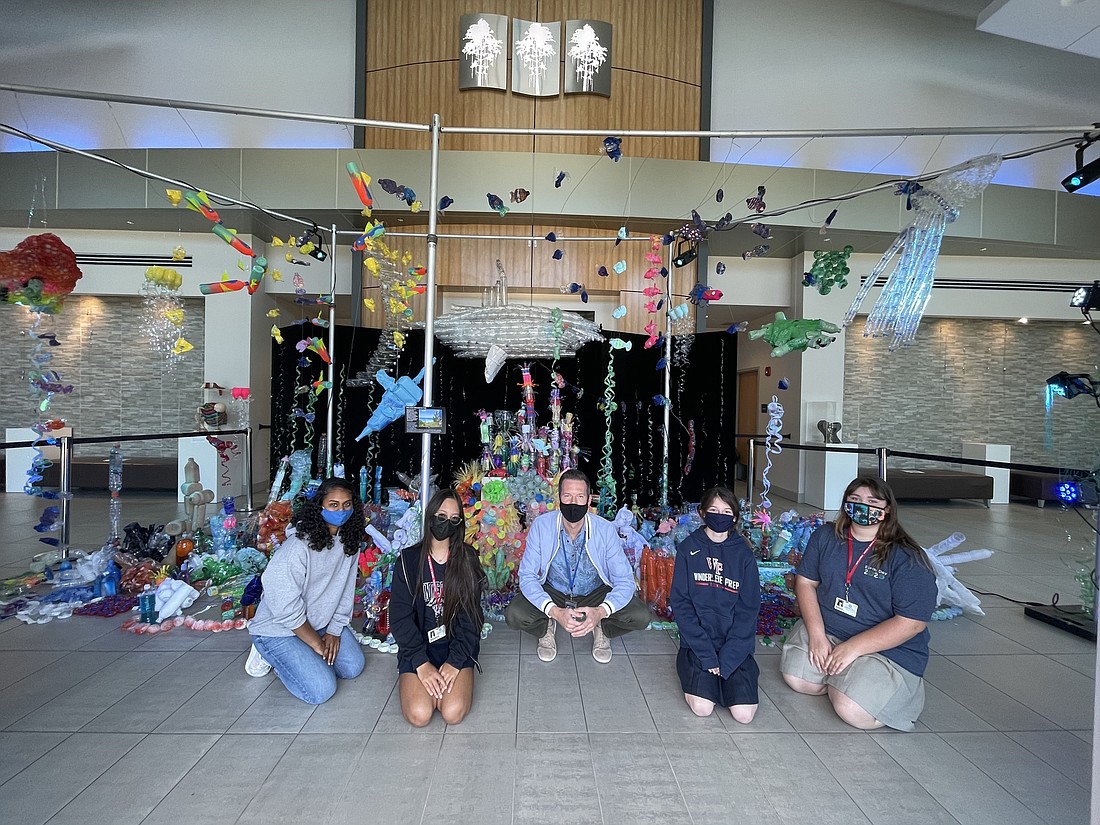- December 18, 2025
-
-
Loading

Loading

The ocean may be an hour away, but Windermere Preparatory School students created their own coral reef right on campus.
“Coral Reef: A Living Wonder” is a collaborative effort between WPS’ middle school visual-arts students and those in the environmental club. The installation — which took two months of work and trial and error from all involved — is comprised of more than 4,000 plastic water bottles and has been on display in the atrium of the Cypress Center.
“The environmental club and the art club … had an idea to create an artwork that was basically addressing climate change,” said Damon Boardman, the middle school visual-arts teacher. “Originally, they said they were going to get some water bottles around campus, collect them, and we were going to build some art with it.”
They decided to make it a contest among all the middle school homerooms to see who could collect the most plastic water bottles to contribute to the project. After one week, the final tally was 4,200 — a sight to behold, Boardman said.
“We started thinking about ideas of what we wanted to do,” he said. “After a meeting or two, we came up with coral reef and sea life. We see the images of the plastic floating on top, but a lot of us don’t actually get to see what’s happening down below due to pollution and carbon dioxide, which is creating global warming. … We’re trying to show the beauty of it, but we’re also trying to raise awareness of what’s actually happening to it. It’s choking the ocean and contributing to the death of so much sea life.”
Eighth-grader Sasha Vallabhaneni, president of the environmental club, said the first major obstacle was the cleaning process. The students borrowed plastic kiddie pools from one of the science teachers, filled them with soap and water, and cleaned each bottle over the next two weeks.
“At the beginning, with 20 water bottles, it wasn’t that difficult to wash, clean and dry them,” she said. “But once we got to 4,000, it was like, ‘How are we going to clean all of this on campus?’ Seeing all the water bottles was so overwhelming. … It was almost like we weren’t sure what to do with it. … At some point, we were all ready to just recycle them, but we had to keep going.”
Even with some anxiety on the front end of the project, Boardman said, there was a deadline looming: This project was to be entered into a Nord Anglia Global Campus Art Contest in collaboration with the United Nations. Contest winners will have their projects presented on the big screen in front of the United Nations.
“It was far more than we expected, so it was really important to me to lead them through this process … and make sure we did as much as we could with the time we were given so we could stand behind it at the end and say we did our best,” Boardman said.
The students also had to figure out how they would turn the clean bottles into the sea life. It ended up being a huge team effort.
“Everyone in the middle school that had art class contributed to the project,” said seventh-grader Mia Sanchez Grisales, member of the National Junior Arts Honor Society. “We stayed a lot of lunches, homerooms, Laker labs, all of our free time.”
“I think a big part of the reason this was able to happen at all was because of the whole collaborative effort,” said seventh-grader Claire Sinoff, vice president of the NJAHS. “It was all about strength in numbers, I think, and everyone just experimenting and seeing what worked, what didn’t and what they liked.”
The piece is three-dimensional, and every part of each water bottle was used — from the plastic to the wrappers and caps. The bottlenose dolphin, in fact, has a nose made of bottle caps.
“We experimented with different things to hold it up, like fishing wire, and we did metal wire and also stapled and hot glued things to gather,” said eighth-grader Catherine Cole, president of the NJAHS. “It was just a bunch of, ‘Oh, I think this will work,’ or, ‘Let’s try this’ to try to get it to stay intact.”
Time and teamwork were on their side, as they had the installation complete and submitted to the competition with five minutes to spare.
“The collaboration is just amazing,” Middle School Director Mary Beth Davies told the students. “It’s about being artistic and creative, but you used that to make a statement for something you care about and take a stand about. It’s so well done.”
“I’m really proud of everyone’s accomplishments — coming together and working together to make something this big,” Sasha said. “I still can’t believe that it’s up here and it looks like this, because in the beginning we just had a whole bunch of plastic bottles, and this is what we turned it into.”